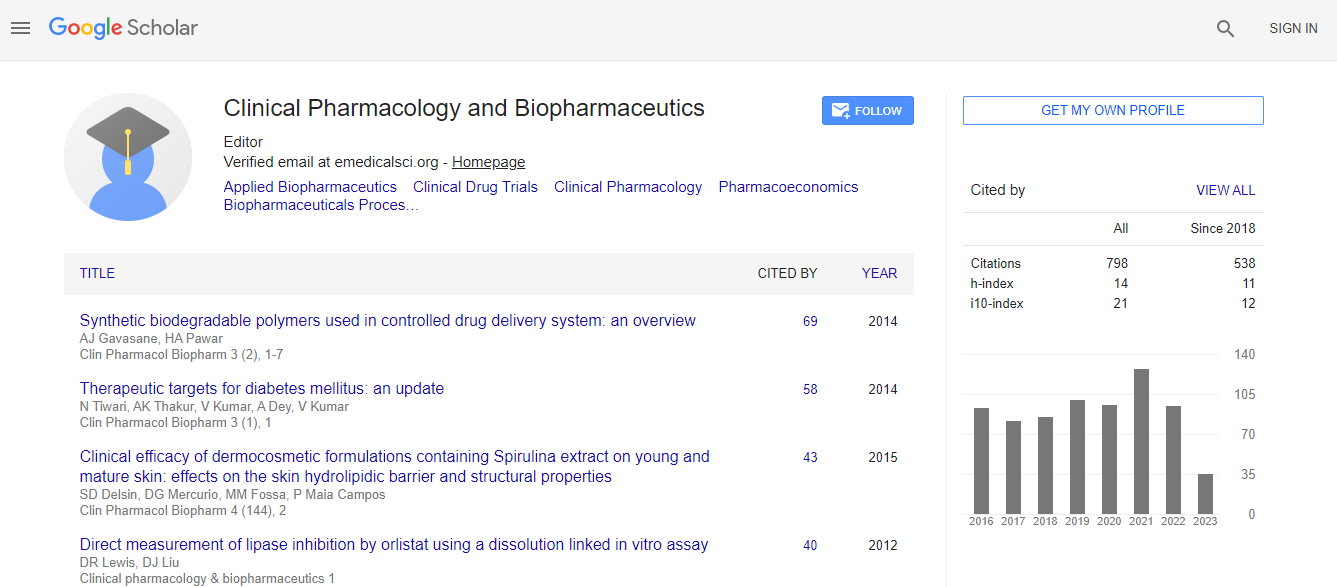Our Group organises 3000+ Global Conferenceseries Events every year across USA, Europe & Asia with support from 1000 more scientific Societies and Publishes 700+ Open Access Journals which contains over 50000 eminent personalities, reputed scientists as editorial board members.
Open Access Journals gaining more Readers and Citations
700 Journals and 15,000,000 Readers Each Journal is getting 25,000+ Readers
Google Scholar citation report
Citations : 1089
Clinical Pharmacology & Biopharmaceutics received 1089 citations as per Google Scholar report
Clinical Pharmacology & Biopharmaceutics peer review process verified at publons
Indexed In
- CAS Source Index (CASSI)
- Index Copernicus
- Google Scholar
- Sherpa Romeo
- Genamics JournalSeek
- RefSeek
- Hamdard University
- EBSCO A-Z
- OCLC- WorldCat
- Publons
- Euro Pub
- ICMJE
Useful Links
Recommended Journals
Related Subjects
Share This Page
The key to Manufacturing Viral Vaccines for individual Human Population
6th European Biopharma Congress
Tirasak Pasharawipas
Rangsit University, Thailand
Posters & Accepted Abstracts: Clin Pharmacol Biopharm
Abstract
Nowadays, subunit viral vaccine becomes the major choice for manufacturing viral vaccine with a thought of safety reason to prevent side effects. However, the success to use subunit viral vaccine to prevent a particular viral infection is very limit. This is different from the time when Cowpox virus was originally used for vaccination to prevent the smallpox viral epidemic over a century ago. Although the knowledge of immunity has been discovered a lot more than the Edward Jenner’s period, the effectiveness of viral vaccine could not reach our accomplishment. Accordingly, we need to revise our knowledge and manipulate in the right direction for the viral vaccine production. Basically, to induce an immunity to prevent a viral infection, our body must produce a specific antibody which needs induction not only by a particular viral antigen but also the molecules called major histocompatibility complex (MHC). Each molecule of MHC alleles plays a key role in the immune response by forming a specific complex with its appropriate epitope to induce a specific T cell clone thru its specific receptor. MHC class I is required for inducing cytotoxic T cell while MHC class II is for helper T cell. Helper T cell plays a key role to induce an effective stage of acquired immunity especially a specific antibody which is believed to be a gearwheel to prevent an invasion of the particular viral particle. To produce the viral-specific antibody, MHC class II plays a key role to induce helper T cell and then B cell to synthesize a specific antibody. Since the MHC gene alleles are highly polymorphic so the possibility that individuals have the same gene alleles might be one in a million which, mostly, can be found in those who are an identical twin. Accordingly, a subunit viral vaccine, which contains a limit number of epitopes, would reduce a capacity of an antigen presenting cell, such as a dendritic cell, to process some epitopes to induce the particular helper T cell clones. Subsequently, the corresponding B cell clones cannot synthesize the specific antibody to neutralize the particular infectious viral particle. Accordingly, this presentation will present a different notion and principle to develop a viral vaccine for an individual human population.Biography
E-mail: tirasak4124@yahoo.com

 Spanish
Spanish  Chinese
Chinese  Russian
Russian  German
German  French
French  Japanese
Japanese  Portuguese
Portuguese  Hindi
Hindi 
